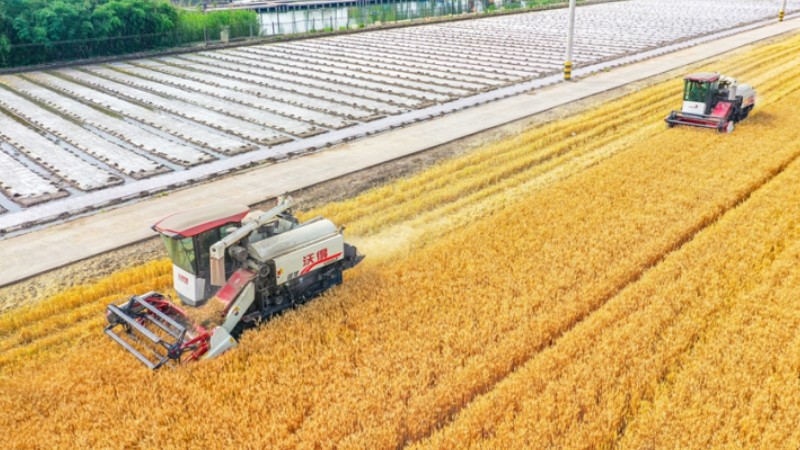China boosts high-quality development of snacks industry
A cultural and tourism event aiming to promote famous Chinese snacks, which kicked off on May 22 in Shaxian district, Sanming city, southeast China's Fujian Province, attracted throngs of consumers for a taste of a wide variety of delicious delicacies.

Workers produce Xiaolongbao, or steamed bun, a famous delicacy, at a food company in Shaxian district, Sanming city, southeast China's Fujian Province. (Xinhua/Lin Shanchuan)
"The snacks satisfied me. And I learned about food cultures of many regions. It was a visit so unforgettable," said Li Wei, a tourist from the provincial capital Fuzhou.
In recent years, a range of iconic regional snack brands such as Shaxian delicacies from Shaxian, Lanzhou beef noodles in Lanzhou city, northwest China's Gansu Province, and river snail rice noodles, or "luosifen," a dish known for its pungent smell in Liuzhou city, south China's Guangxi Zhuang Autonomous Region, have gained in prominence, meeting people's diversified consumption demands while becoming the calling cards for the regions.
China's snacks industry is a big industry that helps boost consumption, improve public well-being and stabilize employment, said Wang Dongtang, director-general of the Department of Trade in Services and Commercial Services at the Ministry of Commerce (MOFCOM) during a meeting on the development of the snacks industry, which was hosted by the ministry and held concurrently in Shaxian with the cultural and tourism event.
Data showed that over 6 million business entities and over 20 million people in China are involved in the catering industry, and annual catering revenue is approaching 4.4 trillion yuan ($619 billion), with snacks becoming the largest category in the catering market.
Chinese online food delivery giant Meituan said the number and transaction value of snack food orders account for about 60 percent, and over 50 percent of the total takeaway orders, respectively.
"At present, China's catering market has recovered rapidly, enterprise confidence constantly grows, and new scenarios and business forms emerge. Vigorously developing the snacks industry will promote the high-quality development of the catering sector and meet the people's need for a better life," Wang said.
Chinese regions have promoted the development of the snacks industry in various ways, including rolling out favorable policies, creating new consumption scenarios, and integrating the industry with other sectors such as tourism, cultural and creative industries.
Liuzhou city has built industrial parks for luosifen production and e-commerce parks, and advertised the delicacy on e-commerce platforms and in shops, supermarkets, exhibitions and scenic areas. Over 100 million parcels of luosifen have been delivered annually for two consecutive years.
The integration of luosifen and tourism has become a new highlight of Liuzhou's cultural and tourism market. The city has rolled out a tourism route themed on luosifen. During this year's May Day holiday, Liuzhou recorded over 3.9 million tourist visits, generating revenue of nearly 3.6 billion yuan, up 103.6 percent and 111.1 percent, respectively.
"During the process of promoting high-quality development of the snacks industry, integrated development is an inevitable trend," said Song Xiaoxi, vice president of the China Hospitality Association.
Song believes that the integration of the snacks industry with sectors including tourism, cultural and creative industries, and ready-to-cook dishes can drive the development of industries such as the planting sector, and production and processing of raw materials, thus contributing more to socio-economic development.
Shaxian district has expanded the snacks industrial chain. It has set up planting bases of snack foods’ ingredients, including edible fungi and spices, which cover about 60,000 mu (4,000 hectares), with 20,000 farmer households being engaged in the planting industry. The district has established the Shaxian Snacks Industrial Park with an annual output value of 500 million yuan. Shaxian delicacies attract over 5 million tourist visits to the district every year.
While developing the snacks industry, a market-oriented and government-guided approach should be followed, and efforts should be made to keep business entities fully motivated, optimize business environment, build brands, and improve relevant standards, Wang said.
Wang called for building snack industrial clusters to promote the coordinated development of the snacks industrial chain, creating famous brands to carry forward fine Chinese food culture, improving the quality of the snacks sector, and further releasing the potential of snacks consumption.
Noting that snack foods are an indispensable part of Chinese cuisine culture, Xing Ying, president of the World Federation of Chinese Catering Industry, suggested making innovations based on traditional cuisine techniques by drawing on different local food cultures to make snacks more attractive and competitive.
Wu Ying, vice president of the China Cuisine Association, called for a better business environment for the sound and sustainable development of the snacks sector.
Wang said the MOFCOM will roll out multiple measures to promote standardization, branding and digitalization of the snacks industry and promote the high-quality development of the sector.
Photos
Related Stories
- China's catering industry prospers during May Day holiday
- China pledges support for consumption in catering sector
- China's catering sector sees robust rebound
- Performer happy about reviving restaurant business
- China's catering industry in steady recovery thanks to optimization of COVID-19 response
- Catering culture expo held in Yulin, South China's Guangxi
Copyright © 2023 People's Daily Online. All Rights Reserved.









